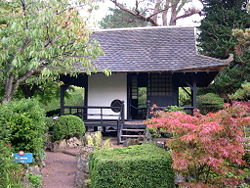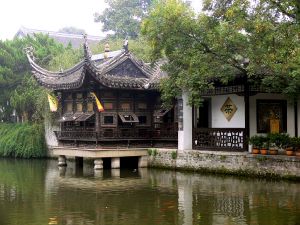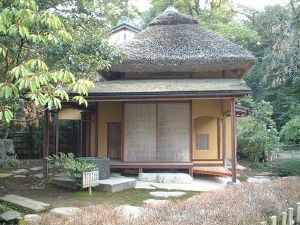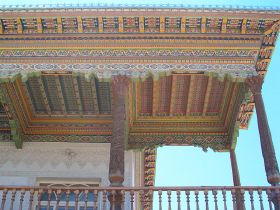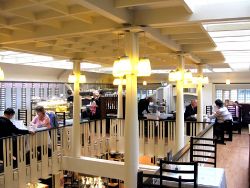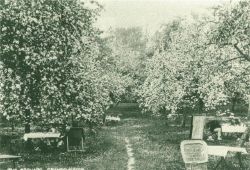Difference between revisions of "Tea house" - New World Encyclopedia
| Line 75: | Line 75: | ||
==Elsewhere== | ==Elsewhere== | ||
[[Image:Tea isfahan.jpg|thumb|right|Interior ''Chaee-Khaneh'' in [[Isfahan]], [[Iran]]]] | [[Image:Tea isfahan.jpg|thumb|right|Interior ''Chaee-Khaneh'' in [[Isfahan]], [[Iran]]]] | ||
| − | Around the world, the term "tea house" or "tea room" may be used to refer to a restaurant or ''Salon de Thé''. They are also present in the [[Middle East]], notably in [[Iran]] and [[Turkey]]. Such tea-houses may be referred to as ''Chaee-Khaneh'' - literally, the "house of tea." These tea houses usually serve several [[beverage]]s, ([[tea]], [[coffee]]), and some serve [[Hookah]] | + | Around the world, the term "tea house" or "tea room" may be used to refer to a restaurant or ''Salon de Thé''. They are also present in the [[Middle East]], notably in [[Iran]] and [[Turkey]]. Such tea-houses may be referred to as ''Chaee-Khaneh'' - literally, the "house of tea." These tea houses usually serve several [[beverage]]s, ([[tea]], [[coffee]]), and some serve [[Hookah]]. |
| − | |||
| − | |||
==Notes== | ==Notes== | ||
Revision as of 22:28, 9 December 2008
- "Tearoom" redirects here.
A tea house or tearoom is a venue centered on drinking tea. Their function varies widely depending on the culture, and some cultures have a variety of distinct tea-centered houses or parlors that all qualify under the English language term "tea house" or "tea room."
History
Asia
China
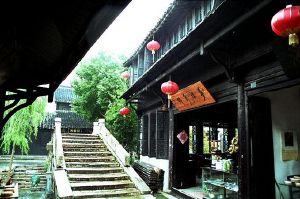
In China, a tea house (茶馆, "cháguăn" or 茶屋, "cháwū") is traditionally quite similar to the American "cafe", albeit centered around tea rather than coffee. People gather at tea houses to chat, socialize, and enjoy tea. Young people often meet at tea houses for dates. Especially, the Guangdong (Cantonese) style teahouses are very famous abroad, such as in New York, San Francisco and etc. these tea houses not only serve tea, but also dim sum (点心), people can eat different kinds of food when they drink tea. People call these kinds of tea house named “茶楼, chálou”.
The ritualized drinking of tea is often practiced in China. The most important work on tea making is the Cha Jing. It is the only extant work of the Tang Dynasty scholar and poet Lu Yu and was written during the 700s. He describes many aspects of tea making from the location of the teahouse to the mode of drinking. His treatise is considered definitive by many.
In Northern Imperial China teahouses were regarded as retreats for gentlemen and later for businessmen. Deals would be discussed and sealed in the neutral, relaxed surroundings of a teahouse rather than in offices.
Teahouses were and are places where disputes could be settled harmoniously over tea. Courts of law are not spots where most people feel at ease. The Chinese at times replaced this setting with a teahouse and the presence of a mutually respected arbiter. The disputing parties would agree on terms and apologies, pay for the tea, shake hands and part in peace. In the same way that insurance agencies and stock brokerages in England developed out of simple coffee shops, teahouses in China were (and still are) used as places to conduct business.
Some teahouses in Hong Kong still uphold such a tradition and are frequented by Hong Kong Chinese industrialists and entrepreneurs. Traditional teahouses can still be found in the older communities. One example is the Luk Yu Teahouse in Central Hong Kong.
Japan
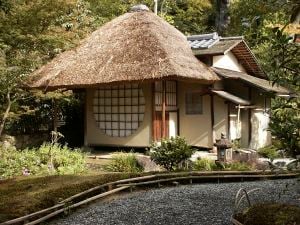
In Japanese tradition a tea house (茶室, chashitsu lit. "tea room") can refer to a structure designed for holding Japanese tea ceremonies. Tea rooms for tea ceremonies, whether they comprise an independent structure or one room within a larger architectural structure, are also called chashitsu in Japanese. The architectural space called chashitsu was created for aesthetic and intellectual fulfillment.
In Japan a tea house (お茶屋, ochaya) can also refer to a place of entertainment with geisha, the most notable of which is the Ichiriki Ochaya. These kind of tea houses are typically very exclusive establishments.
The Ichiriki Ochaya (translated Ichiriki Teahouse) is one of the most famous and historic Ochaya in Kyoto, Japan (note that Ochaya are distinct from Chashitsu). It is located on Shijo-dori Street near the heart of the district of Gion, and is considered an exclusive and high-end establishment, access is invitation only and entertainment can cost upwards of 800,000 yen a night.
The Ichiriki Ochaya is over 300 years old, and has been a major centerpiece of Gion since the beginning of the entertainment district. Like other Ochaya in Gion, the Ichiriki was a place where men of status and power went to be entertained by Geisha, who distracted guests through dancing, banter, and flirtation. The Ichiriki has tradtitionally entertained those of political and business power.
Tajikistan
There are many tea houses in Tajikistan. The largest tea-houses are Orient Tea house or Chinese Tea house, Orom Tea house in (Isfara) town. On the 15th anniversary of Independence in Tajikistan, the people of Isfara town presented Isfara Tea house to Kulyab city for its 2700th anniversay on September 2006.
Egypt
In Egypt, coffee houses are called 'ahwa' and combine serving coffee as well as tea and tisanes. Tea is called "shai", and coffee is also called "ahwa". Finally, tisanes as karkade is also highly popular. [1]
Germany
In Germany, tea house(also called Teehaus) was famous during the Third Reich era where the German Dictator Adolf Hitler used to have his daily walk and tea at a Teehaus on Mooslahnerkopf hill near his residence Berghof, in the Bavarian Alps. Hitler's tea house was a round cylindrical structure built in the woods where Hitler, his close friends, party colleagues and secretaries used to have their daily afternoon walk followed by tea. Tea was Adolf Hitler's favourite drink during his reign. It seems having a separate tea house was a culture in many countries in Europe.
United Kingdom
In the United Kingdom, a tearoom is a small room or restaurant where beverages and light meals are served, often catering chiefly to women and having a sedate or subdued atmosphere. A customer might expect to receive cream tea or Devonshire tea, often served from a china set, and a scone with jam and clotted cream – alternatively a High tea may be served. In Scotland teas are usually served with a variety of scones, pancakes, (Scottish) crumpets and other cakes. Tearooms are often adorned with bird cages filled with exotic birds to create a relaxing atmosphere.
Thomas Twining opened the first known tea room in 1706, which remains at 216 Strand, London today. In 1787 the company created its logo, still in use today, which is thought to be the world's oldest commercial logo that has been in continuous use since its inception.[2] Under Associated British Foods since 1964, Stephen Twining now represents the company's ten generations. In 2006, Twinings celebrated its 300th anniversary, with a special tea, and associated tea caddies. Twining's is a Royal Warrant holder (appointed by HM The Queen).
The popularity of the tearoom rose as an alternative to the pub during the temperance movement in the 1830s. The form developed in the late 1800s, as Catherine Cranston opened the first of what became a chain of Miss Cranston's Tea Rooms in Glasgow, Scotland. Miss Cranston had conceived the idea of a series of "art tearooms," venues where people could meet to relax and enjoy non-alcoholic refreshments in a variety of different "rooms" within the same building. She worked together with internationally renowned architect Charles Rennie Mackintosh to design her tea rooms, which a a result made available a unique, avant-garde artistic world to thousands of ordinary people, with the result that their tea rooms became internationally famous. The last and most famous of these establishments, the Willow Tearooms on Sauchiehall Street with its famous "Room de Luxe" stretching the width of the building above the main entrance and front tearoom, opened for business in October 1903 and, following substantial renovation in the 1980s, remains open today.
While other cities offered very expensive and very basic tea rooms by 1901, Miss Cranston set the standard in Glasgow for more welcoming establishments. Rooms were provided for ladies only and for gentlemen only, as well as luncheon rooms where they could dine together and smoking rooms and billiards rooms for the gentlemen. Miss Cranston's Tea Rooms became social centers for all, for businessmen and apprentices, for ladies and ladies' maids. The Ladies Rooms were a particular success, newly allowing respectable women to get out and meet together without male company. Following her success, similar establishments opened throughout Scotland.
There is a long tradition of tea rooms within London hotels. In the 1880s fine hotels in both the United States and England began to offer tea service in tea rooms and tea courts, and by 1910 they had begun to host afternoon tea dances as dance crazes swept both the U.S. and the UK. Tea rooms of all kinds were widespread in Britain by the 1950s, but in the following decades cafés became more fashionable, and tea rooms became less common.
The Orchard is a tea garden in Grantchester, near Cambridge which opened in 1897. A popular retreat for Cambridge students, teachers, and tourists, it includes many famous names among its patrons. The history of The Orchard started in 1897 when a group of Cambridge students asked the landlady, Mrs Stevenson of Orchard House, if they could take their tea in the orchard rather than on the front lawn as the custom was. This practice soon became the norm, and the place grew in popularity. The next phase in the history of The Orchard began when the poet Rupert Brooke took up lodging in the house in 1909. A graduate student of great popularity in the university community at the time, Brooke soon attracted a great following at the place, among them Virginia Woolf, John Maynard Keynes, E. M. Forster, Bertrand Russell, Augustus John, and Ludwig Wittgenstein – the so-called Grantchester Group. Today the Orchard is open every day of the year and can be reached both by road from Cambridge or by punt down the River Cam.
Bettys and Taylors of Harrogate, a Swiss-Yorkshire family company with seven locations in North Yorkshire, England. Bettys Café Tea Rooms are traditional tea rooms serving traditional meals with influences both from Switzerland and Yorkshire. The first Bettys tea room was opened on Cambridge Crescent in Harrogate, North Yorkshire, by Frederick Belmont, a Swiss confectioner, in July 1919.[3] The Harrogate tea rooms later moved to their current position on Parliament Street.
In a related usage, a tearoom may be a room set aside in a workplace for workers to relax and (specifically) take refreshment during work-breaks. Traditionally a staff member serving food and beverages in such a tearoom would have been called a tea lady.
United States
Elsewhere
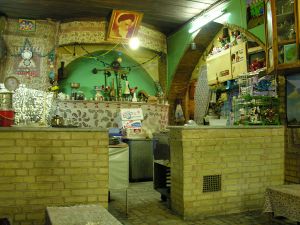
Around the world, the term "tea house" or "tea room" may be used to refer to a restaurant or Salon de Thé. They are also present in the Middle East, notably in Iran and Turkey. Such tea-houses may be referred to as Chaee-Khaneh - literally, the "house of tea." These tea houses usually serve several beverages, (tea, coffee), and some serve Hookah.
Notes
- ↑ Ahwa's in Egypt
- ↑ Tom Standage, (2005). A history of the world in six glasses. New York: Walker. P. 202.
- ↑ "Mysterious Betty of cream teas", The Yorkshire Post, 21 July 1979.
ReferencesISBN links support NWE through referral fees
- Standage, T. 2005. A history of the world in six glasses. New York, NY: Walker
- Kinchin, Perilla. 1998. Taking Tea with Mackintosh: The Story of Miss Cranston's Tea Rooms. Pomegranate Communications. ISBN 0764906925
- Richardson, Bruce. 2008. The Great Tea Rooms of Britain. Perryville, KY: Benjamin Press. ISBN 978-0979343117
- Richardson, Bruce. 2008. Great Tea Rooms of America. Perryville, KY: Benjamin Press. ISBN 978-0979343155
- Pettigrew, Jane, and Bruce Richardson. 2008. The New Tea Companion. Perryville, KY: Benjamin Press. ISBN 978-0979343179
- Gautier, Lydia. 2006. Tea: Aromas and Flavors Around the World. San Francisco, CA: Chronicle Books. ISBN 978-0811856829
- Heiss, Mary Lou, and Robert J. Heiss. 2007. The Story of Tea: A Cultural History and Drinking Guide. Berkeley, CA: Ten Speed Press. ISBN 978-1580087452
- Kilian, Cynthia. 2006. 'Russian' Back: Famed Tea Room Set to Reopen New York Post, October 30, 2006. Retrieved December 9, 2008.
External links
- Home page
- Brooke's The Old Vicarage, Grantchester on Wikisource
| ||||
| Black tea | Blended and flavored teas | Chinese tea | Earl Grey tea | Green tea | Herbal tea | Lapsang souchong | Masala chai | Mate tea | Mint tea | Oolong tea | Turkish tea | White tea | Yellow tea | ||||
| Tea culture | Related to tea | |||
| China | India | Japan | Korea | Morocco | Russia | United Kingdom | United States | Samovar | Tea house | Teapot | Tea set | |||
Credits
New World Encyclopedia writers and editors rewrote and completed the Wikipedia article in accordance with New World Encyclopedia standards. This article abides by terms of the Creative Commons CC-by-sa 3.0 License (CC-by-sa), which may be used and disseminated with proper attribution. Credit is due under the terms of this license that can reference both the New World Encyclopedia contributors and the selfless volunteer contributors of the Wikimedia Foundation. To cite this article click here for a list of acceptable citing formats.The history of earlier contributions by wikipedians is accessible to researchers here:
The history of this article since it was imported to New World Encyclopedia:
Note: Some restrictions may apply to use of individual images which are separately licensed.
